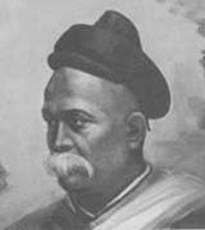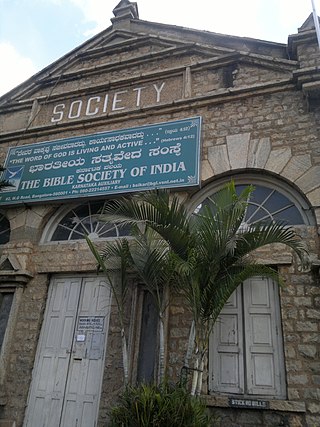Related Research Articles

William Carey was an English Christian missionary, Particular Baptist minister, translator, social reformer and cultural anthropologist who founded the Serampore College and the Serampore University, the first degree-awarding university in India.

Rao Bahadur Mahadev Govind Ranade, popularly referred to as Nyayamurti Ranade or Justice Ranade, was an Indian scholar, social reformer, judge and author. He was one of the founding members of the Indian National Congress party and owned several designations like Member of The Bombay Legislative Council and Member of The Finance Committee at the centre. He was also a judge of the Bombay High Court, Maharashtra.

Joshua Marshman was a British Christian missionary in Bengal, India. His mission involved social reforms and intellectual debates with educated Hindus such as Raja Ram Mohan Roy.

Pandita Ramabai Sarasvati was an Indian social reformer. She was the first woman to be awarded the titles of Pandita as a Sanskrit scholar and Sarasvati after being examined by the faculty of the University of Calcutta. She was one of the ten women delegates of the Congress session of 1889. During her stay in England in early 1880s she converted to Christianity. After that she toured extensively in the United States to collect funds for destitute Indian women. With the funds raised she started Sharada Sadan for child widows. In the late 1890s, she founded Mukti Mission, a Christian charity at Kedgaon village, forty miles east of the city of Pune. The mission was later named Pandita Ramabai Mukti Mission.

The Bible Society of India is a Christian body that is authorized to translate, produce, distribute and market the Bible and is a member of the United Bible Societies.
Meera Kosambi was an Indian sociologist.
Ratnakar Hari Kelkar was a revisor and translator of the Bible into Marathi.

Bible translations into Chinese include translations of the whole or parts of the Bible into any of the levels and varieties of the Chinese language. The first translations may have been made as early as the 7th century AD, but the first printed translations appeared only in the nineteenth century. Progress on a modern translation was encumbered by denominational rivalries, theological clashes, linguistic disputes, and practical challenges at least until the publication of the Protestant Chinese Union Version in 1919, which became the basis of standard versions in use today.

Marathi Christians are an Ethno-religious community of the Indian state of Maharashtra who accepted Christianity during the 18th and 19th centuries during the East India Company, and later, the British Raj. Conversions to Protestantism were a result of Christian missions such as the American Marathi Mission, Church Mission Society and the Church of England's United Society for the Propagation of the Gospel.
Yisu Das Tiwari (1911–1997) was an Indian theologian and a leading participant in Hindu-Christian dialogue.

Christianity is a minority religion in Maharashtra, a state of India. Approximately 79.8% of the population of Maharashtra are Hindus, with Christian adherents being 1.0% of the population. The Roman Catholic archdiocese whose seat is in Maharashtra is the Roman Catholic Archdiocese of Bombay. There are two different Christian ethnic communities in Maharashtra: the East Indians, who are predominantly Roman Catholic, and the Marathi Christians, who are predominantly Protestant with a small Roman Catholic population. The Catholics in Maharashtra are mainly concentrated in coastal Maharashtra, especially Vasai, Mumbai, and Raigad, and are known as East Indians; they were evangelized by Portuguese missionaries during the 15th–16th centuries. Protestants, who reside throughout the Maharashtra, being significant in Ahmednagar, Solapur, Pune, Aurangabad, and Jalna, are called Marathi Christians, who were evangelized by British and American missionaries during British rule in India. The Church of North India has dioceses in the state and is a large Protestant church with full communion with the Anglican Church.

Ramabai Ranade was an Indian social worker and one of the first women's rights activists in the early 20th century. At the age of 11, she was married to Justice Mahadev Govind Ranade, who was a distinguished Indian scholar and social reformer.
The Serampore Mission Press was a book and newspaper publisher that operated in Serampore, Danish India, from 1800 to 1837.

John Wilson FRS was a Scottish Christian missionary, orientalist and educator in the Bombay presidency, British India.

The modern Hindi and Urdu standards are highly mutually intelligible in colloquial form, but use different scripts when written, and have lesser mutually intelligibility in literary forms. The history of Bible translations into Hindi and Urdu is closely linked, with the early translators of the Hindustani language simply producing the same version with different scripts: Devanagari and Nastaliq, as well as Roman.
Languages spoken in the Indian Subcontinent belong to several language families, the major ones being the Indo-Aryan languages spoken by 75% of Indians and the Dravidian languages spoken by 20% of Indians. Other languages belong to the Austroasiatic, Sino-Tibetan, Tai-Kadai, and a few other minor language families and isolates. India has the world's second-highest number of languages (780), after Papua New Guinea (839). The first known translation of any Christian Scripture in an Indian language was done to Konknni in 1667 AD by Ignazio Arcamone, an Italian Jesuit.
The Bible has been translated into the Nepali language several times. Beginning in 1821 with the first New Testament translation, these were historically translated and published in India. More recently, translations like the Nepali New Revised Version in 1997 have been translated and published in Nepal. Other recent versions like the Trinitarian Bible Society edition continue to be made in India specifically in the dialect of Nepali spoken in India.

Nathaniel B. Halhead of the East India Company published a Bengali grammar for British officials in 1776 to aid interaction with the local Bengali population. William Carey of Serampore translated the Bible into the Bengali language and published it in 1793 and 1801. The high language Bengali translation in use in Bangladesh is derived from Carey's version, while "common language" versions are newer translations. Fr. Christian Mignon, a Belgian Jesuit, finished a revised version of the Bible in Bengali, named Mangalbarta, which has copious footnotes. Missionaries have also translated the Bible into "Musalmani Bangla", as well as the Chittagonian and Sylheti dialects.
Gordon Hall was one of the first two American Board of Commissioners for Foreign Missions missionaries to Bombay, then-headquarters of Bombay Presidency. He was instrumental in establishing Bombay Missionary Union, and he was the founder of the Bombay Mission or American Marathi Mission, the first American overseas mission station in the world at Bombay.
Panchanan Karmakar (Mallick) (died c. 1804) was an Indian Bengali inventor, born at Tribeni, Hooghly, Bengal Presidency, British India, hailed from Serampore. He assisted Charles Wilkins in creating the first the Bangla type. His wooden Bengali alphabet and typeface had been used until Ishwar Chandra Vidyasagar proposed a simplified version. Apart from Bangla, Karmakar developed type in 14 languages, including Arabic, Persian, Marathi, Telugu, Burmese and Chinese.
References
- ↑ Journal of the Asiatic Society: 1 Asiatic Society (Calcutta, India) - 1959 - Thus it may be concluded that after Vaidyanath had translated the Bible into Marathi for six months to Carey's satisfaction, the latter found for him a suitable employment in the Fort William College. The Marathi Bible was, however, ...
- ↑ Journal of sacred literature: 5 p 520 John Kitto, Henry Burgess, Benjamin Harris Cowper - 1853 ... the labours of Charles Rhenius (1790-1838), with the Tamil version ; the Bombay translations of the Bible into Marathi and Gujerati; the Canarese Bible completed at Bellary ; the publication of the entire Hindustani Old Testament by Mr. J. A. Schurman and Mr J. A. F. Hawkins.
- ↑ The Indian postcolonial: a critical reader p178 Elleke Boehmer, Rosinka Chaudhuri - 2010 The history of translation in Europe cannot be rendered independent of translations, for example, of the Bible into Marathi or Bangla, merely two of the languages used in the South Asian subcontinent; or any of the languages used in ...
- ↑ A history of missions in India Julius Richter - 1908 A great deal of work and perseverance has been expended on the translation of the Bible into Marathi. Carey, it is true, had been Professor of Marathi at Fort William College, but his translation of the Bible into this language ...
- ↑ Studies in translation p 134 Ed. Mohit K. Ray - 2008 translated by the Serampore missionaries under the supervision of Dr. William Carey, the members of the American Marathi Mission, founded in Mumbai in 1813, undertook the project of retranslating their Bible into Marathi of an ...
- ↑ American Missionaries and Hinduism: a study of their contacts from ... Sushil Madhava Pathak - 1967 Improving upon the imperfect translation of the Bible into Marathi by Carey, Messrs, Hall and Newell, the two American missionaries at Bombay, brought out a standard Marathi translation of the entire Bible in 1826.
- ↑ National Cyclopædia of American Biography p. 56. 1896.
- ↑ Pandita Ramabai Ramabai Sarasvati (Pandita) - 1979 And, that undertaking she could perhaps have easily accomplished with less trouble and difficulty, than what she was confronted with while translating the Bible into Marathi — simpler form of Marathi, so that any common man with ...
- ↑ She has done a beautiful thing for me: portraits of Christian ... p139 Anne C. Kwantes - 2005 Having studied the biblical languages, Pandita Ramabai began to translate the whole Bible into Marathi, her mother tongue, which was spoken in the Pune area. She used very simple language, so that even poorly educated women would be ...
- ↑ India's Bene Israel: a comprehensive inquiry and sourcebook Shirley Berry Isenberg - 1988 - Miss Victoria Brazier and a Jewish printer Mr. Aaron Jacob Divekar of the Bene Israel community played an important part in the publishing house, [p.292] In 1904 she [Ramabai] started her translation of the Bible into Marathi. ...
- ↑ "WatchTower publications", Watchtower publications Index (1986-2016)